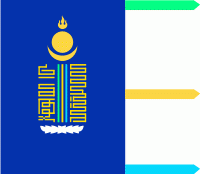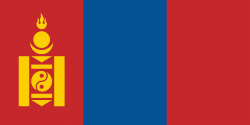Övörkhangai Province (South Khangay)
 |
 |
The Shankh Monastery, one of the oldest and most important monasteries, is located in this province, as well as Erdene Zuu monastery and Tövkhön Monastery. Karakorum, the ancient capital of the Mongol Empire was located adjacent to the Erdene Zuu monastery.
Övörkhangai Provincee held its first Special Olympics games events in 2015.
The Arvaikheer Airport (AVK/ZMAH) has one unpaved runway and is served by regular flights to Ulaanbaatar and Altai.
Bus travels from Arvaikheer to Ulaanbaatar every day.
Map - Övörkhangai Province (South Khangay)
Map
Country - Mongolia
 |
 |
| Flag of Mongolia | |
The territory of modern-day Mongolia has been ruled by various nomadic empires, including the Xiongnu, the Xianbei, the Rouran, the First Turkic Khaganate, and others. In 1206, Genghis Khan founded the Mongol Empire, which became the largest contiguous land empire in history. His grandson Kublai Khan conquered China proper and established the Yuan dynasty. After the collapse of the Yuan, the Mongols retreated to Mongolia and resumed their earlier pattern of factional conflict, except during the era of Dayan Khan and Tumen Zasagt Khan. In the 16th century, Tibetan Buddhism spread to Mongolia, being further led by the Manchu-founded Qing dynasty, which absorbed the country in the 17th century. By the early 20th century, almost one-third of the adult male population were Buddhist monks. After the collapse of the Qing dynasty in 1911, Mongolia declared independence, and achieved actual independence from the Republic of China in 1921. Shortly thereafter, the country became a satellite state of the Soviet Union, which had aided its independence from China. In 1924, the Mongolian People's Republic was founded as a socialist state. After the anti-communist revolutions of 1989, Mongolia conducted its own peaceful democratic revolution in early 1990. This led to a multi-party system, a new constitution of 1992, and transition to a market economy.
Currency / Language
| ISO | Currency | Symbol | Significant figures |
|---|---|---|---|
| MNT | Mongolian tögrög | ₮ | 2 |
| ISO | Language |
|---|---|
| MN | Mongolian language |
| RU | Russian language |















